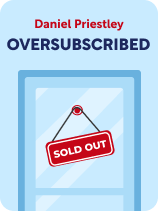

This article is an excerpt from the Shortform book guide to "Oversubscribed" by Daniel Priestley. Shortform has the world's best summaries and analyses of books you should be reading.
Like this article? Sign up for a free trial here.
What’s the most effective way to stand out from competitors? Is it wise to undercut your competitors’ prices?
The central theme of Oversubscribed by Daniel Priestley is to have more customers than you can handle. So, a great deal of the book is devoted to ways of attracting those customers. One of those ways is to differentiate your product from all the others on the market.
Keep reading to learn how to differentiate a product and neutralize the competition.
How to Differentiate a Product
Priestley says that the best way to get people talking about you is to be unusual or remarkable in some way; in other words, find a way to stand out from the crowd and attract people’s attention. Here, we’ll discuss how to differentiate a product and attract that attention.
Method #1
First, the most effective way to stand out is to offer something truly unique—if you have no competition, then you won’t need to vie for people’s attention in the first place. If that’s the case, you can build a strong customer base before imitators start pushing their way into the market.
| Unique Products Come From Extremes If your goal is to create something unique and remarkable, don’t try to make something “good,” meaning a product with broad appeal that everyone will want to buy. As Seth Godin explains in Purple Cow, any “good” product you come up with almost certainly exists already. Instead, Godin encourages you to go the opposite direction: Brainstorm what extremes you could take your product to, regardless of how popular you think it will be. For example, a very spicy candy bar (an extreme flavor) won’t be as popular as regular milk chocolate, but you won’t have to compete with established brands like Hershey’s. Some other possible extremes are quality, price, and product appearance. Godin adds that once you have an idea, don’t compromise on it. Any kind of compromise is almost certainly going to push you back toward “good”—an unremarkable product that most likely already exists. |
Method #2
Second, if you can’t create a unique product, then you’ll need to give yourself an edge over your competitors. One strategy is to undercut their prices; if you can provide similar products at a lower price than your rivals, people will tend to favor your company. IKEA uses this strategy—by selling disassembled furniture that’s easy to pack and transport, IKEA saves money on shipping and therefore can sell its products at lower prices than other furniture companies.
(Shortform note: In Purple Cow, Godin warns that having a low cost isn’t a good way to stand out, especially for a new or small company—larger competitors that can afford to sell at a loss will always win the price war. The one exception to this guideline is if you have some innovation in your production process, like IKEA does, that significantly reduces your overhead costs.)
Method #3
A third way of attracting attention is to offer a product that’s more convenient than the current options. For example, streaming services have largely replaced cable TV because streaming allows you to watch what you want, when you want, instead of having to follow a network’s schedule.
(Shortform note: Sometimes, making a more convenient product doesn’t require overhauling the product itself, just changing how people use it. For example, in Purple Cow, Godin explains how Schindler Elevator Corporation dominated the market by improving how people interact with elevators: Rather than simply making elevators bigger or faster, Schindler integrated a computer into its elevators that calculates the most efficient way to get all the passengers to their destinations, then tells them which elevator to take.)

———End of Preview———
Like what you just read? Read the rest of the world's best book summary and analysis of Daniel Priestley's "Oversubscribed" at Shortform.
Here's what you'll find in our full Oversubscribed summary:
- Why you should build demand for your product before you even release it
- How to run a successful marketing campaign
- Why word-of-mouth advertising is more effective than mass marketing






